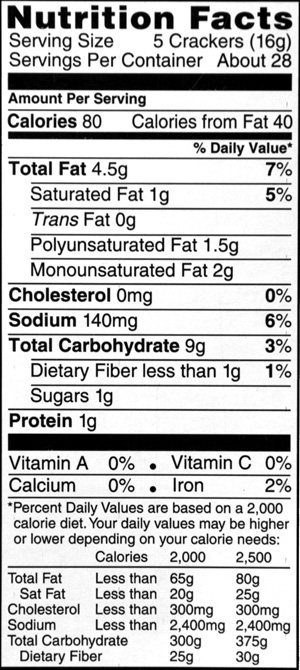Tips for Understanding Nutrition Labels

We are all very familiar with the nutrition label that comes on our foods. However, do you really know how to read it? The nutrition label is designed to provide us with a quick and easy way to make smart decisions about choosing healthy foods. The problem with this is that a lot of people don’t quite know how to take in the information that is on the nutrition label without spending a lot of time reviewing it. Luckily, there are some easy tips that you can follow to make it a whole lot simpler to benefit from the nutrition labels on your food.
Here are some tips for reading, understanding and using food nutrition labels:
· Look for low levels of the first nutrients that are listed. You might not have known this but there actually is a purpose to the way that nutritional labels are organized. The first nutrients that are listed are the nutrients that you want to make sure to limit in your diet. The total fat, cholesterol and sodium levels are listed here. You want to select foods that are low in these areas so that you don’t get too much of these things into your diet.
· Look for high levels of the latter nutrients. The process of organization on the nutritional label makes sense once you learn more about it. First, you will look at those nutrients that you don’t want a lot of. Then it only makes sense to look at the nutrients that you do want in your diet. The nutrients that are listed further down the label – the fiber, vitamins and minerals – are the nutrients that you want to get a lot of. Look for foods that are rich in these nutrients when reviewing nutrition labels.
· Remember the 5/20 rule. It can be really tough to remember how much of each nutrient is the right amount to fit into your diet. That’s why the nutritional label provides you with really handy information about the percent daily value of each item that is listed. Many people get confused even by this, though, because they aren’t sure how much of a percentage they want from a single food item. The basic rule of thumb to remember is the 5/20 rule which says that 5% or lower is a low amount and 20% or higher is a high amount. You want to generally choose foods that have percentages within this range (although lower is better when it comes to those top-of-the-label nutrients). There is more to nutrition than just this, of course, but remembering this will make it a lot easier to glance at nutrition labels and make quick decisions in the store.
· What about calories? In general, the average person is recommended to eat a 2000 calories per day diet. When you look at the top of your nutrition label, you will see that information is provided there about the number of calories in a single serving of the product. If you’re trying to stick within the average diet, you will want to know that there is a general rule to follow in regards to the calories. The rule is that 40 calories is a low-calorie food and 400 calories is a high-calorie food. Sticking in between these two with your foods, assuming that you eat an average diet, should keep you on track with eating the right amount of calories.
· Don’t forget to check the serving size. Right at the top of every nutritional label is information about how many servings are in the package. This is important because it affects the rest of the information that you’re looking at. For example, if a product has 10 grams of fat in a single serving but there are two servings in the package and you’re going to eat the whole package then you are actually getting 20 grams of fat. Make sure that you double-check this serving size information when calculating out what you’re eating using the nutritional label.
· Ignore the footnote. The bottom of the nutrition label is called the footnote. This footnote lists information about the total grams of nutrients that are recommended for either a 2000 calorie diet or a 2500 calorie diet. This is great information for people to learn about in general. You can check this part of the label out now and then to make sure that you are not getting too many grams of fat into your diet, etc. However, this is probably not something that you need to concern yourself with every single time that you look at a nutrition label in the store. It’s good information but if you’re looking at the other things on this list then you should be doing okay. It’s not necessary to add in more information when reviewing every single nutrition label.
· Pay close attention to the foods that your purchase most often. You may not feel like you have the time to look at the nutritional labels on all of the foods that you buy. That’s okay. You can get a good start by checking out the labels on the foods that you purchase most often. Since you are already buying them, you can do this at home when you have some downtime. This will at least give you a good idea about some of the basic nutrition that you are and are not getting.






